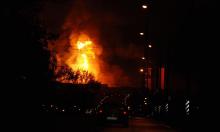2005 quake in Indonesia caused massive coral death, researchers say
A 2005 earthquake off the coast of Indonesia pushed an island 1.2 meters (3.9 feet) out of the water, causing one of the biggest cases of coral deaths recorded, scientists said Friday.
Researchers surveying the island of Simeulue in March found that most corals along its 300-kilometer (190-mile) perimeter had been partly raised out of the water by the 2005 earthquake, with the exposed parts dying off. It is believed to be the first time that scientist have documented the impacts on corals from a quake.
"The scale of it was quite extraordinary," said Andrew Baird, of the Australian Research Council Centre of Excellence for Coral Reef, who took part in the survey with scientist from the Wildlife Conservation Society. "Exposed corals were everywhere."
Baird, who said their findings would be published later this year, said exposed corals stretched from a few meters from shore to as far as 500 meters (1,640 feet). "Some species suffered up to 100 percent loss at some sites, and different species now dominate the shallow reef," he said.
More than 900 people were killed and tens of thousands left homeless in the 8.7 magnitude earthquake that hit Nias, Banyak and Simeulue islands off the coast of Sumatra. The quake came three months after the 2004 tsunami, which left 230,000 people in a dozen Indian Ocean countries dead or missing.
Australian reef expert Clive Wilkinson, who did not take part in the survey, said the damage to the reefs on Simeuleu was to be expected, given the amount of uplift that occurred and the severity of the quake.
"I don't think it's anything new. This has been going on for millions of years," Wilkinson said. "It's part of natural reef evolution. There are many islands in the Pacific that are actually uplifted coral reefs. It's just what happens to reefs."
Baird and his fellow researchers painted a mixed picture for the reefs' future. While those that were raised in Simeuleu are largely lost and will become coastal forests, those just beneath the water's surface are likely to grow back - as long as local communities protect them.
"The news from Simeulue is not all bad," Stuart Campbell, coordinator of the Wildlife Conservation Society's Indonesia Marine Program, said in a statement.
"At many sites, the worst affected species are beginning to re-colonize the shallow reef areas," he said. "The reefs appear to be returning to what they looked like before the earthquake, although the process may take many years."
Baird said their findings should give hope to communities in the Solomon Islands, where concerns have been raised that an April 2 earthquake and tsunami might have damaged its reef ecosystem and in turn its diving industry.
"They shouldn't be worried about losing their dive industry," Baird of the Solomon Islands.
"Everything still in the water will still be fine," he said. "Reefs can respond to these massive mortality events. They can power on through it as long as there is enough good reef out there."
Subscribe to Pravda.Ru Telegram channel, Facebook, RSS!





